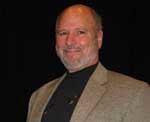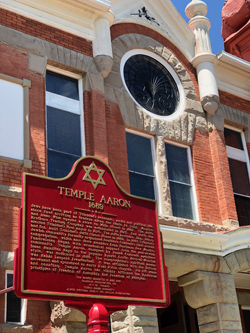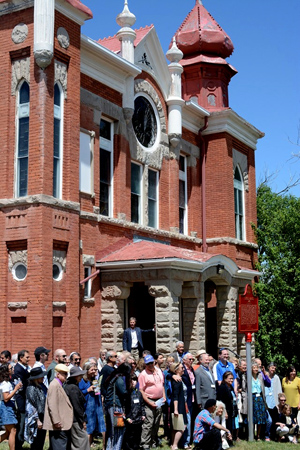By Jerry Klinger


TRINIDAD, Colorado — Temple Aaron in this city celebrated its 130th birthday, Big Time on the weekend of June 21-23.
The Temple is 200 miles from Denver, 200 miles from Albuquerque, 200 miles from nearly everything sustainably Jewish. Its last full-time rabbi died 103 years ago. Yet, the town enduringly refuses to release the rich memory of generations before.
If only the stones could speak…
Trinidad is located aside the famed the Santa Fe trail that led through the Rocky Mountain pass at Raton, New Mexico. It was founded in 1862 when coal was discovered nearby.
The arrival of the Atchison, Topeka and Santa Fe Railroad in 1878 seemingly guaranteed coal as King. It was thought to ensure Trinidad’s unending, economic prosperity as a colorful Western boom town. Its history includes Western mythological names, mountain man, explorer George Simpson, gunfighter and one-time Sheriff Bat Masterson, and writers like Damon Runyon whose early career covering small town baseball brought him in contact with Ina Young, the first female Sports editor in America. She specialized in Baseball reporting for the Trinidad Chronicle. In 1908, Young covered the World Series. Her understanding of the game and ability to compile box scores was better than most men.
The first documented Jews to arrive in Trinidad were brothers Maurice and Isaac Wise who came in 1867. The Wises’ opened a trading store on Main Street.
The residents of tiny Trinidad did not ask if the immigrants were Jewish or not. They asked what can you do, what can you bring to the table, can you build with us? Soon other Jews also arrived, mostly of German background.
The (Jewish) Jaffa Brothers Trading company became a major factor in Trinidad. In fact, Sam Jaffa was elected as Trinidad’s first mayor in 1876.
The young Jewish community lacked two necessities for Jewish durability. They lacked a permanent religious home, a synagogue, so they had to meet for religious services in private homes or in stores. They knew that a synagogue would be more than just a building it would be a statement that the Jews of Trinidad were part of the community– that they had laid down roots and planned to stay.

Members of the community gathered on July 23, 1883 for the bris of Aaron Jaffa. He was the son of Sol Jaffa. Sol Jaffa began the brit milah service with Masonic Rites. The need for a dedicated synagogue space, a Temple was self-evident. Fundraising began to build a Temple that would affiliate with the Reform movement. The largest donations came from the Jaffa family.
The community formally incorporated that July, naming themselves Temple Aaron in honor of the little boy who made the focus on Jewish life imperative.
Five years of intensive fundraising followed, with financial contributions coming significantly from the non-Jewish community. The Jews hired famed architect Isaac Hamilton Rapp. He designed a Revival-Moorish style edifice. Temple Aaron would be built for the then enormous sum of $12,000.
On June 18, 1889, Temple Aaron held its dedication. the Masons’ “Worshipful Master” Sol Jaffa opened the dedication service with Masonic Rites. He was followed by recently hired Rabbi Leopold Freudenthal from Heidelberg, Germany.
The Honorable S.S. Wallace delivered a full oration on the work Jews had done on behalf of humanity. The dedication service closed with a special address by Rev. W.S. Blackwood.
The Zion Lutheran Community and Temple Aaron became close. As Temple Aaron’s cornerstone was laid, Zion Lutheran was there. When it came time to dedicate Zion Lutheran’s Cornerstone their recently hired Pastor objected to the Jews being there. The Lutheran community solved the situation simply. They got rid of the Pastor. Temple Aaron was present at Zion Lutheran’s dedication.
Rabbi Freudenthal led Temple Israel for the next 27 years. He officiated over all life cycle events, headed the school, and represented the Jewish community. Freudenthal’s death in 1916, marked the peak of King Coal for Trinidad.
The succeeding decades saw a slow erosion of Trinidad’s economy. With fewer and fewer opportunities, Temple membership dropped. Despite all, a core of Temple Aaron’s congregation kept the Temple and community together. It was a religious passion born of survival on the frontier.
In 1954, Dr. Stanley Bieber, a general surgeon, took a job at a United Mine Workers clinic in Trinidad. Biber was an active member of Temple Aaron.
Life was pretty straight forward for Dr. Biber in Trinidad until a desperate plea for help pulled at his heart in 1969. A trans-woman asked him to surgically complete her identity. Biber had never performed gender reassignment surgery but then no one in the world had done it either. Biber became the pioneer of the new frontier of medicine. Until his retirement in 2003 at age 80, Trinidad was the safe haven for the desperate seeking surgical transition. Biber performed over 2,000 procedures, developed techniques, and taught scores of other doctors how to assist those whom no one would help, those who barely survived life hiding in the shadows.
Though many people came to Trinidad for their specialized needs it did not significantly impact the economy of the region.
Ironically, today another formerly illegal activity has impacted Trinidad, the legalization of Marijuana. More than a score of retail dispensaries have sprung up in Trinidad selling pot, about one for every 350 residents. It brings in millions of tax dollars for Trinidad.
The Temple Aaron community of memory refuses to die even if the handwriting is on the walls that the Jews are not returning. They think of life, somehow…
The Jewish American Society for Historic Preservation (JASHP) learned of Temple Aaron’s struggle for life. After approaching David London, a member of the board, a proposal was made that seemed incredulous to London and his fellow board members. JASHP was willing to spend thousands of dollars to fund a historical interpretive roadside marker outside of Temple Aaron to tell their story, the story of Jews, Trinidad and the memory of their yesterdays.
On June 22, 2019, after services, as part of a three-day celebration of life, the bright red marker with the Star of David at its crest, was dedicated. Over a hundred congregants, friends and community supporters came, Jew, and Gentile.
The day before the dedication, I went to the Trinidad History Museum to see what they might have about the Jewish story.
It is not unusual for Jewish names to mentioned as being key in a community. It is also not unusual for the name not to be identified as Jewish – just a name. The Trinidad Museum did more than that; they had an entire interpretive wallboard about the Jews of Trinidad.
They were proud that Jews were part of their story.
Just inside the gate of the Trinidad History Museum is a boulder affixed with a plaque. It is the story of a Black woman who lived and died in Trinidad. Her name was Cathay Williams. For two years, Cathay Williams had hidden her femininity and served as a Buffalo Soldier on the American Western Frontier.
The text of the Temple Aaron marker:
Jews have been part of Trinidad’s social, economic and political life since first arriving as traders along the Santa Fe Trail. Maurice and Isaac Wise opened a store on Main Street in 1867. The Jaffa Brothers’ Trading Company was established in 1872. Sam Jaffa was elected as Trinidad’s first mayor in 1876. The Jaffa brothers, Sam, Henry and Sol, built Trinidad’s Jaffa Opera House in 1882. In 1883 Trinidad’s Jewish community formally organized Southern Colorado’s first Jewish congregation, which also drew members from Northern New Mexico. Fundraising began with ecumenical support from the non-Jewish community. Temple Aaron, designed by famed architect Isaac Hamilton Rapp in the popular hybrid Exotic Revival-Moorish style, was dedicated in 1889. The Congregation’s spiritual leader was Rabbi Leopold Freudenthal. It was affiliated with the Reform Movement and sponsored an early B’nai B’rith chapter. For 130 years and counting, Temple Aaron has visibly affirmed the American principles of Freedom of Assembly and Freedom of Religion.
This marker dedicated June 2019
Colorado Preservation, Inc., City of Trinidad, Temple Aaron,
Jewish American Society for Historic Preservation
*
Jerry Klinger is the President of the Jewish American Society for Historic Preservation. www.JASHP.org
Pingback: Trinidad, Colorado, celebrates Temple Aaron | B'nai B'rith Budapest Páholy